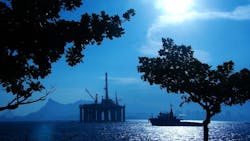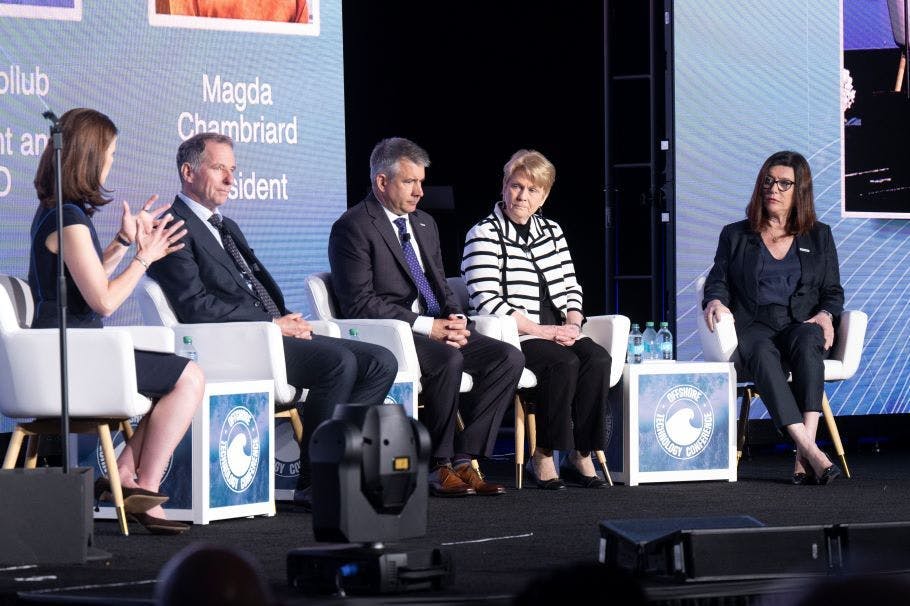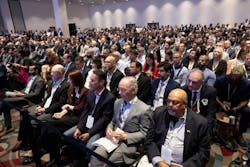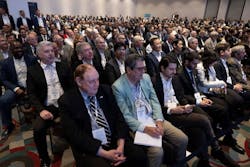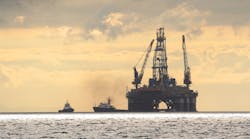OTC 2025: Industry leaders voice opinions about top regions, policy, tariffs and AI at opening ceremony
By Ariana Hurtado, Editor-in-Chief
The Offshore Technology Conference (OTC) kicked off on May 5 in Houston, and the opening ceremony featured a high-level executive panel of Vicki Hollub, Oxy president and CEO; Magda Chambriard, Petrobras president and CEO; Erik Milito, NOIA president; and Jarand Rystad, Rystad Energy CEO.
The top three countries were identified at the start of the session by Rystad—Guyana, Brazil and in the longer term Namibia (a new growth area), but a large part of the group discussion Monday morning circulated around the Gulf of Mexico/Gulf of America (depending on which panelist was speaking).
Rystad also boasted about the offshore sector's "world record" growth from 48 MMbbl/d in 2019 to 50 MMbbl/d in 2025—"the highest production ever from offshore globally." He expects that to increase to 55 MMbbl/d by 2031, adding, "we can be quite certain about that because offshore is a longer cycle than other cycles, you know, than onshore and shale."
The Gulf
Hollub said eventually US shale is going to plateau and then start to decline, and the Gulf is going to help the country maintain its energy independence.
"There's no better place to try to make sure that we can come up with more recoveries and more development than in the Gulf of America," Hollub said. "In five to 10 years, the Gulf has to produce, the Gulf has to get stronger and better and deliver more for the United States, because you got to offset the declines that we're going to see from the shale."
The Gulf is a complex area and more needs to be done in the region, she added. "The more leases that we have [and] the more data we can gain, the better we're going to understand it," and thus develop it better, she said.
Milito added that he's "bullish on the offshore." He said the Gulf is currently producing 1.7 MMbbl/d to 1.8 MMbbl/d and could get up to 2.2 MMbbl/d to 2.4 MMbbl/d "despite geopolitical uncertainties."
Policy and investment
Milito went on to say that government policy is going to be playing a bigger role in the ability for companies to invest with confidence.
"When you see the Trump administration coming in with 'drill, baby, drill,' and firing off a slew of executive orders on January 20, those were, in many respects, designed to open up acreage, to open us (the country) up for investment and for leasing," he said. "There's a lot happening there to provide greater certainty, but the tension on the oil and gas side is with the tariffs. I was at a Rystad event last week, and they mentioned how the tariffs could have a cost impact offshore of over 17%. That's incredible, and that is not sustainable."
Hollub added, "I definitely think the administration is listening, and they have people that know our industry. So President Trump is a big supporter. He's working through issues that are important to the United States, but I think ultimately we'll get to a point where the administration will remove obstacles for us, and then once we get through this volatility around the tariffs, I believe that we're in a situation where we'll be provided the certainty that we need to make these long-term decisions. So I'm very optimistic about where we're headed."
For Petrobras and the Brazil region, Chambriard said it's the oil price drop that is making the biggest impact.
"We have to challenge our suppliers to help us and support us, providing simple and less expensive projects," she said. "So this is what really impacts us. We are challenging our local suppliers. We are challenging our international suppliers in order to have lower costs to make projects viable. Otherwise, we will not take advantage of so many opportunities."
Technology and AI
The panelists also covered CCUS and their plans to continue pushing toward emissions reduction.
Chambriard said they are working on three big CCUS projects in Brazil. She added, "Energy transition is a reality for us, but we have to realize that all of these are possible because we make money on the petroleum industry."
The speakers also touched on the application of AI to increase efficiencies.
"We're definitely focused on the application of AI in a much bigger way in the subsurface Gulf of Mexico to try to understand it better and get more out," Hollub said.
She continued, "These are $100 million dollar wells in some cases, and that warrants a lot of investment in AI to make it understandable. And so I believe that the Gulf could actually drive the advancement of AI for the industry as a whole, whether it's here in the United States or other areas. But we've got to make offshore more successful from an exploration standpoint and also from a field development standpoint."
On the geophysical side, Milito said that seismic companies are able to put greater resolution on the data so new operators can look at it to make more informed decisions and take better capital risks when it comes to their exploration activities.
He added, "AI and data analytics are allowing the geophysicists to come up with better resolution data so that the companies can make better educated decisions when it comes to exploration."
Looking ahead
Another sentiment that continues to be repeated across the industry lately is about collaboration.
As Houston Mayor John Whitmore said during his speech just ahead of the panel, "I've never been in the room with so many smart people in my life."
Talent and experience are flooding the session rooms of OTC, and this week the industry will continue to have conversations about advancing technologies, the world's most promising regions, evolving policy and regulations, and what's in store for the offshore sector in the years ahead.
This story was last updated at 6:44 p.m. May 5, 2025.
Related content:
About the Author
Ariana Hurtado
Editor-in-Chief
With more than a decade of copy editing, project management and journalism experience, Ariana Hurtado is a seasoned managing editor born and raised in the energy capital of the world—Houston, Texas. She currently serves as editor-in-chief of Offshore, overseeing the editorial team, its content and the brand's growth from a digital perspective.
Utilizing her editorial expertise, she manages digital media for the Offshore team. She also helps create and oversee new special industry reports and revolutionizes existing supplements, while also contributing content to Offshore's magazine, newsletters and website as a copy editor and writer.
Prior to her current role, she served as Offshore's editor and director of special reports from April 2022 to December 2024. Before joining Offshore, she served as senior managing editor of publications with Hart Energy. Prior to her nearly nine years with Hart, she worked on the copy desk as a news editor at the Houston Chronicle.
She graduated magna cum laude with a bachelor's degree in journalism from the University of Houston.
